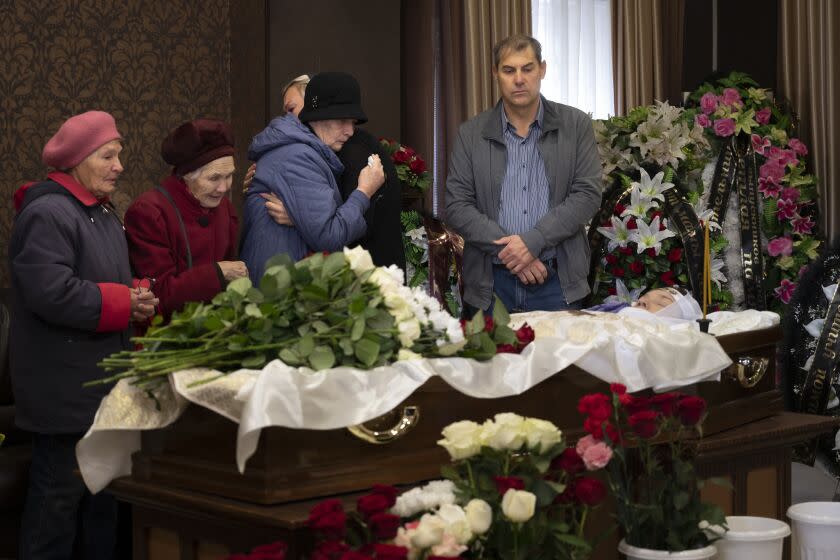Nicholas Goldberg: Did the 23-year-old Columbine attack inspire last week's school shooting in Russia?

When a gunman wearing a swastika on his T-shirt and a black balaclava burst into School No. 88 in the Russian city of Izhevsk on Sept. 26, panicked kids as young as 7 fled through the halls and stairwells or huddled in classrooms. The shooter killed 17 people — including 11 children — and wounded 24 before killing himself.
It’s the same old story, I’m sorry to say, that is so familiar in our own country. And when police finally reached the body of the gunman, they encountered another recognizable trope of school shootings everywhere: a direct reference to the massacre 23 years ago at Columbine High School in Littleton, Colo.
This time, they found braided cords labeled “Dylan” and “Eric” attached to two of the Izhevsk attacker’s pistols.
Those names must have been immediately recognizable even to Russian police. Dylan Klebold and Eric Harris were the trenchcoated Columbine seniors who in 1999 shot dead 13 people and injured 24 others before killing themselves, in the infamous attack that made them role models and glorified antiheroes to far too many troubled young people.
Their cultural staying power has been extraordinary. The “Columbine effect,” as the wave of subsequent copycat attacks has been called, was identified soon after 1999. Like most people, I’d heard of it and was aware that Klebold and Harris had achieved a macabre, folk-hero status among some would-be imitators.
But I wasn’t aware of just how many attacks have been directly influenced by the two, or the degree to which they've gone global. Columbine has been been cited or studied by killers and plotters in Canada, Germany, Sweden, the United Kingdom, the Netherlands and Finland, among other countries.
In February, the Russian state news agency Tass reported that the Russian Supreme Court had designated something called the “Columbine movement” as a terrorist organization. According to the New York Times, Russia’s prosecutor general described it as a decentralized group of gunmen that is “coordinated using the capabilities of the internet.” It has been banned.
Russian authorities connected two attacks to the movement, including a school shooting that killed nine people in Kazan in May 2021 and a university shooting in Perm in September 2021 in which six people were killed.
Of course, these attacks can’t be entirely blamed on Columbine. The copycat phenomenon is only one piece of a complex equation. School shootings can be related to bullying and harassment. They can have roots in the consumption of violent media. In toxic, hyper-masculinity. In the availability of guns. In childhood trauma. In mental illness, often undiagnosed.
But there’s no question that Columbine has helped inspire shooters for nearly 25 years.
Take Sebastian Bosse, who attacked his former school in Emsdetten, Germany, in 2006 wearing a long black coat and carrying two rifles, a pistol and homemade bombs. He wrote in his diary: “Eric Harris is God!”
Seung-Hui Cho, who killed 32 people at Virginia Tech in 2007, called Harris and Klebold “martyrs” and handed in an English paper saying he wanted to “repeat Columbine.”
Adam Lanza, who killed 26 people at Sandy Hook Elementary School in 2012, was obsessed with Columbine, according to Connecticut investigators, and kept hundreds of documents and videos about it.
Kylian Barbey, 17, who injured eight people when he opened fire in 2017 at a high school in the southern French city of Grasse, had been watching videos of the Columbine killings shortly before his attack.
Those are just a few examples. By the 20th anniversary of Columbine in 2019, it had directly influenced dozens of plots and attacks around the world.
How did it become the model? Harris and Klebold weren’t the first school shooters, nor the last, nor even the most deadly. So what is it?
E. Fuller Torrey, founder of the Treatment Advocacy Center in Virginia, says Columbine was the first school shooting to become a giant, 24-hour-news-cycle story and therefore served as a historical marker for those that followed. It was well-documented by videos and writings by the perpetrators, which became available on the internet. Furthermore, Torrey said, Harris and Klebold did not present as psychopaths, yet they held the power of life or death over their schoolmates, including those who had ridiculed and bullied them, refused to date them or excluded them.
“They were appealing to the losers of the world,” Torrey told me.
Ralph Larkin, a sociology professor at John Jay College of Criminal Justice in New York, says Klebold and Harris presented themselves in their manifestos as “defenders of outcast students.” They’d been bullied and subjected to humiliation — accused of being gay, doused in ketchup, that sort of thing. They posted that they wanted to start a revolution of students, to rise up against their tormentors, something troubled students could relate to.
“Harris and Klebold wrote the cultural script,” Larkin says. “They produced a paradigm that has been followed to this day.”
Many people also blame the media, which aired weeks of relentless Columbine coverage and made the killers famous. Some people say news organizations shouldn’t even report the names of mass killers because it encourages copycats.
These days, we — in the U.S., at least — live in a world of active shooter drills, school escape routes, lockable classroom doors and choke-point entrances. Teachers, classmates and parents are supposed to be on the alert for bullying and distress that could feed another shooter.
But the attacks continue. The Washington Post says there were more school shootings in 2021 than in any year since 1999, when it began to keep track.
My heart goes out to the people of Izhevsk. Their children’s deaths barely made our front pages last week, even though the gunman took at least some of his inspiration from our own twisted, demented example.
The Columbine cultural script continues to endanger us all today, here and abroad.
This story originally appeared in Los Angeles Times.

